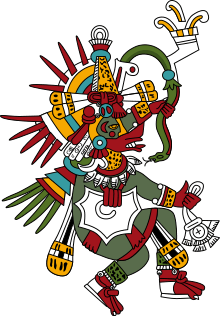Tōnacācihuātl
In Aztec mythology, Tōnacācihuātl (Nahuatl pronunciation: [toːnakaˈsiwaːt͡ɬ]) was a creator and goddess of fertility, worshiped for peopling the earth and making it fruitful.[1] Most Colonial-era manuscripts equate her with Ōmecihuātl.[2] Tōnacācihuātl was the consort of Tōnacātēcuhtli.[3] She is also referred to as Ilhuicacihuātl or "Heavenly Lady."[4]
Etymology
The god's name is a compound of two Nahuatl words: tōnacā and cihuātl.[5] While cihuātl can be translated "woman" or "lady", tōnacā presents several possible interpretations. Some read this root as tonacā (without the long 'o'), consisting of nacatl, meaning "human flesh" or "food," with the possessive prefix to ("our"). By this etymology, Tōnacācihuātl would mean "Lady of Our Food" or "Lady of Our Flesh," most commonly rendered "Lady of Our Sustenance."[2] The word tōnac simply means "abundance," giving Tōnacācihuātl the alternate reading "Lady of Abundance."[5]
Origin and role
Tōnacācihuātl was the Central Mexican form of the creator goddess common to Mesoamerican religions.[2] According to the Codex Ríos, the History of the Mexicans as Told by Their Paintings, the Histoyre du Mechique, and the Florentine Codex, Tōnacācihuātl and her counterpart Tōnacātēcuhtli resided in Ōmeyōcān, the 13th, highest heaven, from which human souls descended to earth.[6][2][4] Tōnacācihuātl is associated with procreation, appearing in pre-Columbian art near copulating humans. In the Florentine Codex, Sahagún relates that Aztec midwives would tell newborns after bathing them, "You were created in the place of duality, the place above the nine heavens. Your mother and father—Ōmetēuctli and Ōmecihuātl, the heavenly lady—formed you, created you."[4]
In 1629, Hernando Ruiz de Alarcón also reported the use of the goddess's name in ritual planting prayers, in which a seed of corn is entrusted to the earth deity Tlaltecuhtli by a shaman who calls the kernel nohueltiuh Tōnacācihuātl ("my sister, the Lady of Abundance").[7]
In the Codex Chimalpopoca, Tōnacātēcuhtli and Tōnacācihuātl are listed as one of several pairs of gods to whom Quetzalcoatl prays.[8]
Notes
References
- Bierhorst, John (1992). History and mythology of the Aztecs: the Codex Chimalpopoca. Tucson, AZ: University of Arizona Press. ISBN 978-0-8165-1886-9.
- Garibay Kintana, Ángel Ma., ed. (1965). Teogonía e historia de los mexicanos: tres opúsculos del siglo xvi. Mexico City: Editorial Porrúa. ISBN 9789684323124.
- León-Portilla, Miguel. Aztec Thought and Culture. University of Oklahoma Press. ISBN 0806122951.
- Miller, Mary; Taube, Karl, eds. (1993). An Illustrated Dictionary of the Gods and Symbols of Ancient Mexico and the Maya. London: Thames & Hudson. ISBN 0500279284.
- Ruiz de Alarcón, Hernando (2014). Tratado de las supersticiones y costumbres gentílicas que hoy viven entre los indios naturales de esta Nueva España. Barcelona: Linkgua digital. ISBN 9788498169607.
- Sahagún, Bernadino (2012). Florentine Codex Book 6: Rhetoric and Moral Philosophy. Translated by Dibble, Charles E.; Anderson, Arthur J. O. Salt Lake City: University of Utah Press. ISBN 978-1607811619.
- Wimmer, Alexis (2006). "Dictionnaire de la langue nahuatl classique" (online version, incorporating reproductions from Dictionnaire de la langue nahuatl ou mexicaine [1885], by Rémi Siméon). Retrieved 2016-04-05.
